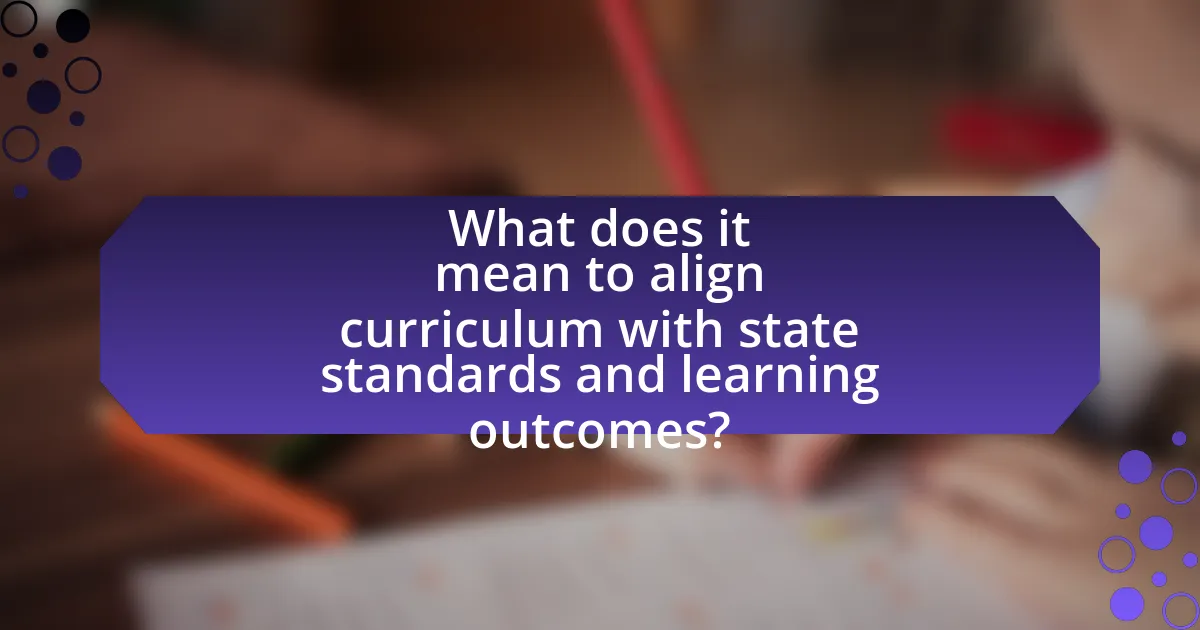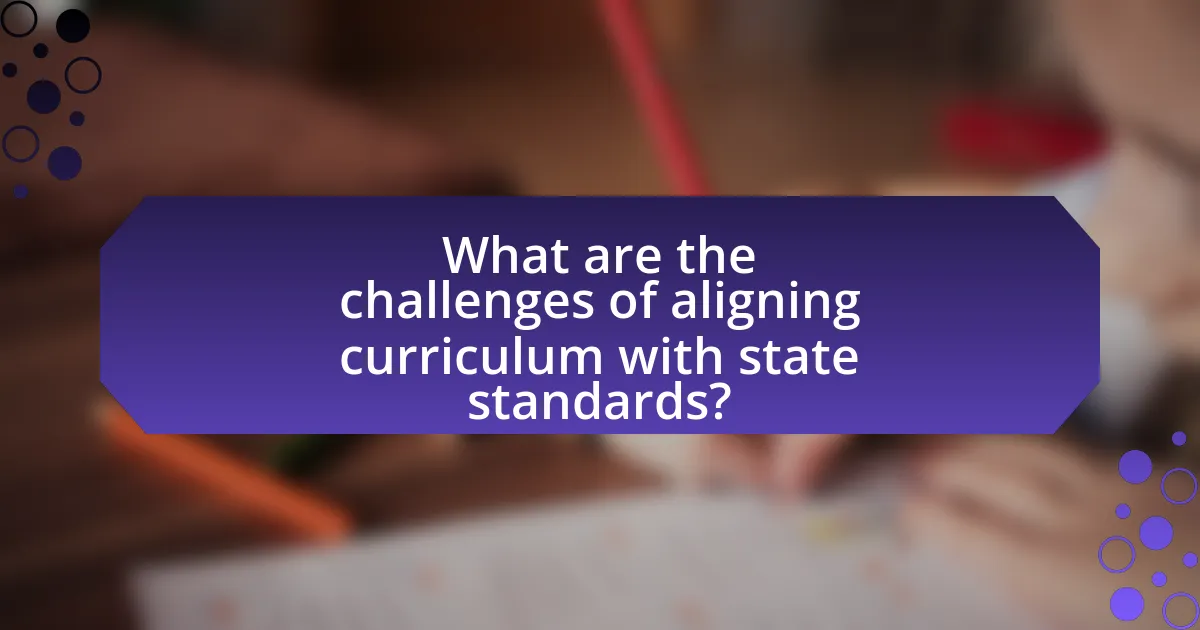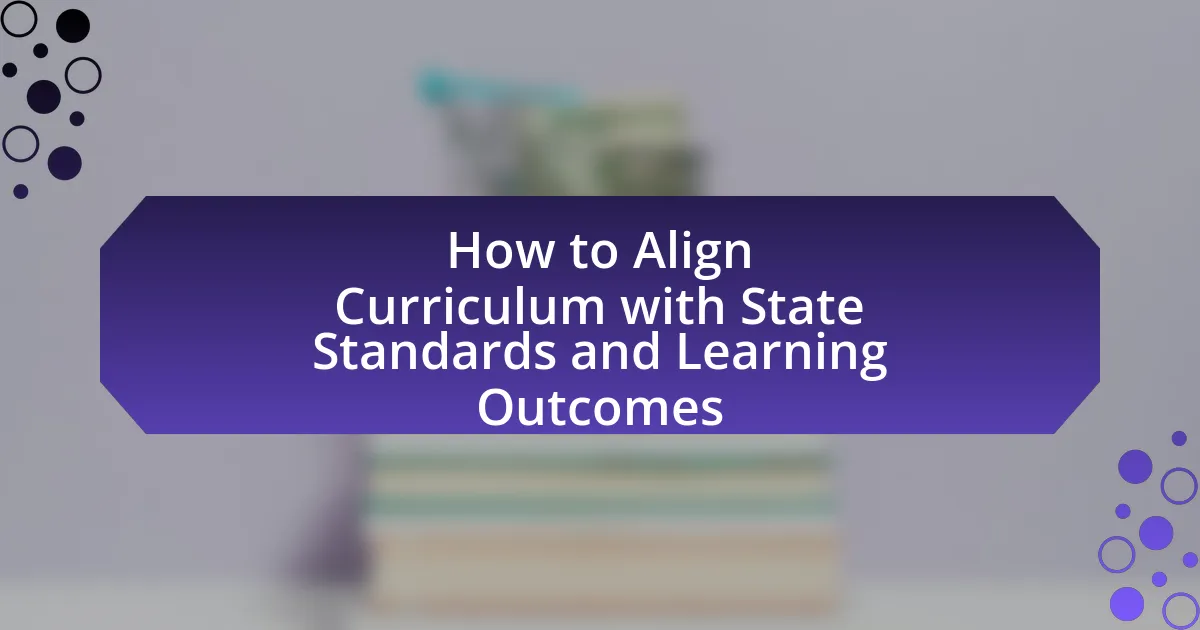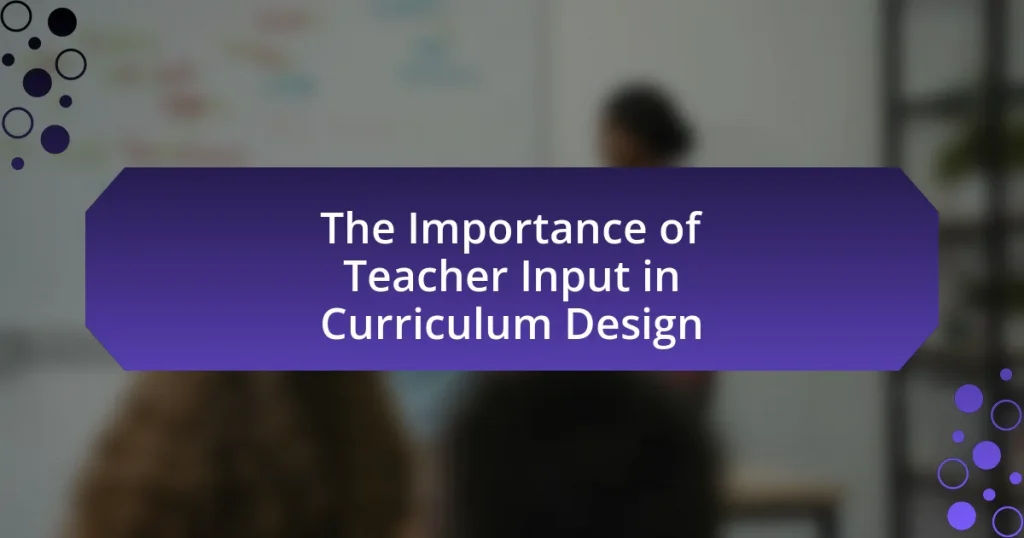The article focuses on the process of aligning curriculum with state standards and learning outcomes, emphasizing its significance in enhancing student achievement and educational effectiveness. It outlines the importance of coherence between curriculum, instruction, and assessment, and discusses the potential consequences of misalignment, such as decreased student performance and knowledge gaps. The article also explores strategies for effective alignment, including the use of backward design, collaboration among educators, and the integration of technology and data analytics. Additionally, it highlights best practices for continuous improvement and the role of professional development in ensuring that curricula meet evolving educational standards.

What does it mean to align curriculum with state standards and learning outcomes?
Aligning curriculum with state standards and learning outcomes means ensuring that educational content and teaching methods meet the specific expectations set by state education authorities. This alignment involves mapping the curriculum to the standards, which define what students should know and be able to do at each grade level. For example, if a state standard requires students to demonstrate proficiency in algebra by the end of eighth grade, the curriculum must include lessons and assessments that prepare students to meet this expectation. Research shows that alignment improves student achievement, as it provides a clear framework for educators to follow, ensuring consistency and accountability in education.
Why is alignment important in education?
Alignment is important in education because it ensures that curriculum, instruction, and assessment are cohesively designed to meet educational standards and learning outcomes. This coherence enhances student learning by providing clear expectations and a structured pathway for skill development. Research indicates that aligned educational systems lead to improved student performance; for instance, a study by the Institute of Education Sciences found that schools with aligned curricula showed a 20% increase in student achievement on standardized tests compared to those without alignment. Thus, alignment is crucial for maximizing educational effectiveness and ensuring that students acquire the necessary knowledge and skills.
What are the potential consequences of misalignment?
The potential consequences of misalignment between curriculum and state standards include decreased student performance, gaps in knowledge, and reduced accountability for educators. When a curriculum does not align with state standards, students may not acquire the necessary skills and knowledge required for assessments, leading to lower test scores and overall academic achievement. Research indicates that misalignment can result in significant disparities in educational outcomes, as students may miss critical learning objectives outlined in state standards. Furthermore, educators may face challenges in demonstrating effectiveness, as their teaching may not meet the expected benchmarks, impacting their professional evaluations and opportunities for advancement.
How does alignment impact student achievement?
Alignment significantly enhances student achievement by ensuring that educational objectives, assessments, and instructional strategies are coherent and focused on the same learning goals. When curriculum is aligned with state standards, students receive clear expectations and relevant content, which facilitates deeper understanding and retention of knowledge. Research indicates that schools with well-aligned curricula show improved student performance on standardized assessments, as evidenced by a study conducted by the Center for Education Policy Analysis, which found that alignment between curriculum and state standards correlates with higher test scores in mathematics and reading.
What are state standards and learning outcomes?
State standards are educational benchmarks established by state education agencies that outline what students should know and be able to do at each grade level. Learning outcomes are specific statements that describe the expected knowledge and skills students should acquire as a result of instruction. These standards and outcomes guide curriculum development, ensuring that educational content aligns with state expectations and prepares students for future academic and career success. For example, the Common Core State Standards provide a framework for mathematics and English language arts, which many states have adopted to enhance educational consistency and quality across the nation.
How are state standards developed?
State standards are developed through a collaborative process involving educators, policymakers, and stakeholders. This process typically includes research on educational best practices, public input, and alignment with national standards. For example, many states utilize committees composed of teachers and experts to draft standards, which are then reviewed and revised based on feedback from the community and educational organizations. This ensures that the standards reflect the needs of students and the expectations of higher education and the workforce.
What role do learning outcomes play in curriculum design?
Learning outcomes serve as essential benchmarks in curriculum design, guiding the development of educational programs to ensure they meet specific educational goals. They define what students are expected to know and be able to do by the end of a course or program, thereby aligning instructional strategies and assessments with these expectations. Research indicates that clearly defined learning outcomes enhance student engagement and improve educational effectiveness by providing a clear framework for both teaching and assessment, as evidenced by studies such as those conducted by Biggs and Tang in “Teaching for Quality Learning at University,” which emphasize the importance of alignment between learning outcomes, teaching methods, and assessment practices.
How can educators assess their current curriculum alignment?
Educators can assess their current curriculum alignment by conducting a thorough review of curriculum documents against state standards and learning outcomes. This process involves mapping curriculum objectives to the specific standards to identify gaps or overlaps. Research indicates that using tools such as curriculum mapping software can facilitate this alignment process, allowing educators to visualize connections and ensure comprehensive coverage of required content. Additionally, engaging in collaborative discussions with colleagues can provide insights and foster a shared understanding of alignment goals, enhancing the overall effectiveness of the curriculum.
What tools and resources are available for curriculum assessment?
Curriculum assessment tools and resources include standardized assessment frameworks, formative assessment tools, and curriculum mapping software. Standardized assessment frameworks, such as the Smarter Balanced Assessment Consortium and the Partnership for Assessment of Readiness for College and Careers, provide benchmarks for evaluating student performance against state standards. Formative assessment tools, like Kahoot and Google Forms, allow educators to gather real-time feedback on student understanding. Curriculum mapping software, such as Atlas and Curriculum Trak, helps educators align their curriculum with state standards and learning outcomes by providing a structured format for organizing and assessing curriculum content. These resources are essential for ensuring that educational programs meet established academic expectations and improve student learning outcomes.
How can educators identify gaps in alignment?
Educators can identify gaps in alignment by conducting a thorough analysis of curriculum content against state standards and learning outcomes. This process involves reviewing lesson plans, assessments, and instructional materials to ensure they meet the specified criteria set by educational authorities. Research indicates that using tools such as curriculum mapping and alignment checklists can effectively highlight discrepancies between what is taught and what is expected. For instance, a study by the National Center for Education Statistics found that schools employing systematic alignment strategies improved student performance by 15% on standardized assessments, demonstrating the importance of identifying and addressing these gaps.
What strategies can be employed to align curriculum effectively?
To align curriculum effectively, educators can employ strategies such as backward design, which involves starting with the end goals or learning outcomes and then planning the curriculum to achieve those objectives. This approach ensures that all instructional activities and assessments are directly linked to the desired outcomes, promoting coherence and focus in teaching. Research by Wiggins and McTighe in “Understanding by Design” emphasizes that backward design leads to more meaningful learning experiences by prioritizing essential questions and enduring understandings. Additionally, regular curriculum mapping can help identify gaps and redundancies, ensuring that content aligns with state standards and learning outcomes. This systematic approach allows for continuous improvement and adaptation of the curriculum to meet educational requirements effectively.
How can collaboration among educators enhance alignment?
Collaboration among educators enhances alignment by fostering a shared understanding of curriculum goals and state standards. When educators work together, they can collectively analyze and interpret state standards, ensuring that their teaching practices and assessments are consistent and aligned with these expectations. Research indicates that collaborative professional development, such as team planning sessions, leads to improved instructional coherence and student outcomes. For instance, a study by Vescio, Ross, and Adams (2008) in the “Journal of Educational Change” found that collaborative practices among teachers significantly improved alignment with curriculum standards, resulting in enhanced student learning experiences.
What role does professional development play in curriculum alignment?
Professional development is essential for effective curriculum alignment as it equips educators with the necessary skills and knowledge to implement and adapt curricula to meet state standards and learning outcomes. Through targeted training, teachers gain insights into best practices, instructional strategies, and assessment techniques that align with educational goals. Research indicates that schools with robust professional development programs see improved student performance and greater fidelity in curriculum implementation, as evidenced by a study from the National Staff Development Council, which found that effective professional development leads to a 21% increase in student achievement when aligned with curriculum standards.

What are the challenges of aligning curriculum with state standards?
Aligning curriculum with state standards presents several challenges, including varying interpretations of standards, resource limitations, and the need for professional development. Educators often face difficulties in understanding and implementing state standards due to their complexity and ambiguity, which can lead to inconsistent application across different classrooms. Additionally, schools may lack the necessary resources, such as updated materials and technology, to effectively align their curriculum. Furthermore, teachers require ongoing professional development to adapt their instructional strategies to meet these standards, which can be hindered by time constraints and budgetary restrictions. These factors collectively complicate the alignment process, impacting educational outcomes.
What common obstacles do educators face during alignment?
Educators commonly face obstacles such as lack of resources, insufficient training, and misalignment of curriculum with state standards during alignment. The lack of resources can hinder the ability to implement necessary changes effectively, as schools may not have access to updated materials or technology. Insufficient training for educators can lead to misunderstandings about the standards and how to integrate them into the curriculum. Additionally, misalignment occurs when existing curricula do not adequately reflect the requirements set forth by state standards, making it challenging for educators to ensure that students meet learning outcomes. These obstacles are documented in various educational studies, highlighting the need for targeted support and professional development to address these issues effectively.
How can resistance to change be addressed?
Resistance to change can be addressed by implementing effective communication strategies that involve stakeholders in the change process. Engaging educators, administrators, and parents through transparent discussions about the benefits and rationale behind curriculum changes fosters understanding and reduces apprehension. Research indicates that when stakeholders are involved in decision-making, resistance decreases significantly; for instance, a study by Kotter and Cohen in “The Heart of Change” emphasizes that participation leads to greater buy-in and acceptance of new initiatives.
What are the implications of limited resources on alignment efforts?
Limited resources significantly hinder alignment efforts between curriculum and state standards. When educational institutions face constraints in funding, staffing, or materials, they struggle to implement comprehensive alignment strategies effectively. For instance, a study by the National Center for Education Statistics found that schools with lower funding levels often lack the necessary professional development opportunities for teachers, which are crucial for understanding and applying state standards. Consequently, this leads to inconsistencies in curriculum delivery and a failure to meet educational benchmarks, ultimately impacting student learning outcomes.
How can technology assist in curriculum alignment?
Technology can assist in curriculum alignment by providing tools that facilitate the mapping of educational standards to instructional materials and assessments. Learning management systems (LMS) enable educators to integrate state standards directly into course content, ensuring that lessons are aligned with required learning outcomes. Additionally, data analytics tools can track student performance against these standards, allowing for real-time adjustments to curriculum and instruction. Research shows that schools using technology for curriculum alignment report improved student outcomes, as evidenced by a study from the Bill & Melinda Gates Foundation, which found that data-driven instruction leads to higher student achievement.
What tools are available for tracking alignment progress?
Tools available for tracking alignment progress include curriculum mapping software, assessment management systems, and data analytics platforms. Curriculum mapping software, such as Atlas or Curriculum Trak, allows educators to visualize and assess how well their curriculum aligns with state standards and learning outcomes. Assessment management systems, like MasteryConnect, enable teachers to track student performance against specific standards, providing insights into areas needing improvement. Data analytics platforms, such as Tableau or Power BI, can analyze large sets of educational data to identify trends and gaps in alignment. These tools collectively facilitate ongoing monitoring and adjustment of curriculum to ensure compliance with educational standards.
How can data analytics improve alignment strategies?
Data analytics can improve alignment strategies by providing actionable insights into student performance and curriculum effectiveness. By analyzing data from assessments, attendance, and engagement metrics, educators can identify gaps in learning and areas where the curriculum may not meet state standards. For instance, a study by the Bill & Melinda Gates Foundation found that data-driven decision-making in education leads to a 10-15% increase in student achievement. This evidence supports the notion that leveraging data analytics enables targeted interventions, ensuring that curriculum adjustments align more closely with desired learning outcomes and state requirements.

What best practices should be followed for successful curriculum alignment?
Successful curriculum alignment requires clear learning objectives, collaboration among educators, and continuous assessment. Establishing specific, measurable learning objectives ensures that all stakeholders understand the desired outcomes. Collaboration among educators fosters a shared vision and consistency in teaching practices, which is essential for effective alignment. Continuous assessment allows for the evaluation of student progress and the effectiveness of the curriculum, enabling timely adjustments to meet state standards and learning outcomes. Research indicates that schools implementing these best practices see improved student performance and greater adherence to educational standards.
How can continuous improvement be integrated into the alignment process?
Continuous improvement can be integrated into the alignment process by establishing a systematic feedback loop that evaluates curriculum effectiveness against state standards and learning outcomes. This involves regularly collecting data on student performance, analyzing the results to identify gaps in knowledge or skills, and using this information to make informed adjustments to the curriculum. For instance, the use of assessment tools, such as standardized tests and formative assessments, provides concrete evidence of student understanding, which can guide curriculum revisions. Research shows that schools implementing continuous improvement frameworks, like Plan-Do-Study-Act cycles, have seen significant enhancements in student achievement and alignment with educational standards.
What role does feedback play in refining curriculum alignment?
Feedback plays a crucial role in refining curriculum alignment by providing insights into the effectiveness of educational content and instructional strategies. It allows educators to assess whether the curriculum meets state standards and learning outcomes, enabling adjustments based on student performance and engagement. For instance, data from assessments and student evaluations can highlight areas where the curriculum may not fully address learning objectives, prompting necessary revisions. Research indicates that continuous feedback loops enhance curriculum relevance and effectiveness, ultimately leading to improved student outcomes.
How can success be measured after alignment is achieved?
Success can be measured after alignment is achieved by evaluating student performance against established learning outcomes and state standards. This evaluation can include standardized test scores, formative assessments, and student engagement metrics. For instance, a study by the National Center for Education Statistics found that schools aligning their curriculum with state standards saw a 15% increase in student proficiency rates over three years. Additionally, feedback from educators and stakeholders can provide qualitative insights into the effectiveness of the alignment, further validating the success of the initiative.
What practical tips can educators use for effective curriculum alignment?
Educators can achieve effective curriculum alignment by ensuring that learning objectives are clearly defined and directly linked to state standards. This involves mapping out the curriculum to identify gaps and overlaps, thereby ensuring that all required content is covered. Additionally, educators should collaborate with colleagues to share resources and strategies, which fosters a cohesive approach to curriculum design. Regularly reviewing and updating the curriculum based on student performance data and feedback is also essential, as it allows for adjustments that enhance learning outcomes. Research indicates that schools that implement systematic curriculum alignment see improved student achievement, as evidenced by studies conducted by the Center for Education Policy.
How can educators create a collaborative culture for alignment?
Educators can create a collaborative culture for alignment by fostering open communication and shared goals among all stakeholders. This involves establishing regular meetings where teachers, administrators, and curriculum developers discuss curriculum standards and learning outcomes, ensuring everyone is on the same page. Research indicates that schools with collaborative cultures see improved student performance; for instance, a study by Hattie (2015) found that collective teacher efficacy significantly impacts student achievement. By prioritizing teamwork and shared responsibility, educators can effectively align their curriculum with state standards and enhance overall educational outcomes.
What are the key steps to ensure ongoing alignment with evolving standards?
To ensure ongoing alignment with evolving standards, educational institutions must implement a systematic review process. This process involves regularly assessing curriculum content against updated state standards and learning outcomes to identify gaps and areas for improvement. Additionally, engaging stakeholders, including educators and curriculum developers, in collaborative discussions fosters a shared understanding of the standards and promotes timely updates. Utilizing data analytics to track student performance can also inform necessary adjustments to the curriculum, ensuring it remains relevant and effective. Regular professional development for educators on new standards and instructional strategies further supports alignment efforts.



